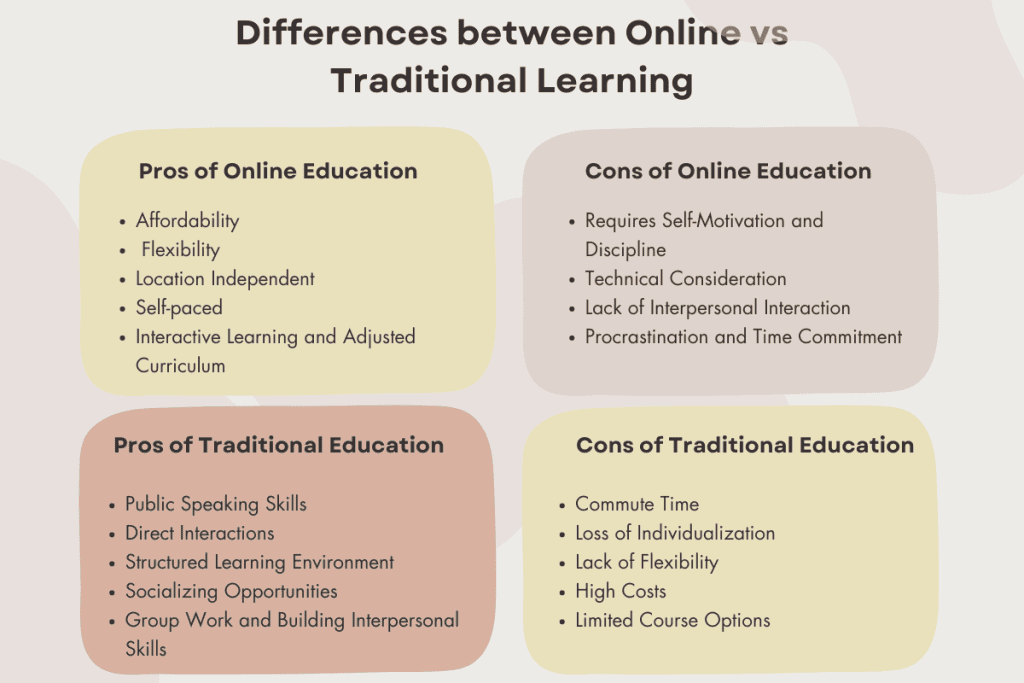Did you know that online learning has grown more than 900% since its inception in the early 2000-s, according to Oxford College research.
When you think about online learning, you probably associate it with higher education or college. Online schooling for primary and secondary education has been available in the USA for 20 years. It is now quickly expanding globally.
Traditional studying for children is no longer the only way of education, as online schools are becoming increasingly popular. As education changes and learning shifts to digital platforms, you probably wonder what makes online studies unique and desirable.
The effectiveness of online learning vs traditional learning depends on factors like student preferences, technology development, and courses taken. This article will explore one simple question: “Is online education better than traditional learning?” To answer that, we need to explore their differences that are crucial for making the right decision.
Differences between Online Learning vs Traditional Learning
Traditional classroom vs online learning involves physical presence and face-to-face interactions between teachers and students. This provides an excellent opportunity to build a sense of community, socialize, and receive feedback.
On the other hand, online education offers more flexibility and convenience to fit learning into your busy schedule. Online learning programs are a modern way of teaching that facilitates learning through the Internet. This is possible because of recent technology advancements.
Online learning has several names, including online schooling, online education, and distance learning or e-learning.
It is important to consider the advantages and disadvantages of online learning vs traditional classroom learning. In that way, you can determine which is best for you.

Pros of Online Education
The online program has numerous benefits. With online education, access to comprehensive education is just a click away! Let’s consider learning outcomes in an online vs traditional course.

1. Affordability
When deciding what learning styles best suit you, consider the cost of online learning vs traditional learning. Online education has a significant advantage in terms of cost-effectiveness.
Students can save money on accommodation, travel, food, traditional books, living on campus, and learning materials. This may result in substantial financial savings, especially for students living in remote, distant areas.
2. Flexibility
Online learning offers greater flexibility and autonomy. Students can choose courses according to their interests and goals, without location, time, or curriculum limitations. This can be very helpful for those who need flexible schedules.
It offers students the freedom to learn at their own pace and convenience. This allows students to tailor their education to suit their individual needs. This strategy guarantees effective time management by emphasizing relevant material. Organizing time effectively is essential for university later in life, and children need to start developing this skill at a young age.
3. Location Independence
Online education allows people worldwide to access data, information, and quality education equally. Whether from small developing nations or London suburbs, students can study from the comfort of their homes.
Our school has a mix of students from around the world, creating a welcoming and diverse learning environment. Multicultural environment provides our students with a safe space to share knowledge and experiences and learn about different nations.
4. Self-Paced
Online learning allows students to learn at their own pace and create a schedule that works best for them. This method of teaching adapts to the individual needs of each learner. Students can customize their learning experiences to fit their unique needs.
This approach enables students to concentrate on topics and tasks that are either interesting or challenging to them. By doing so, they can make the most out of their learning experience. They can also manage their time better, making room for non-school activities like training professional sports, dancing classes, or music activities.
Our school uses adaptive technology to help students learn more efficiently. This technology evaluates each student’s performance and provides resources and feedback to address their individual needs.
It also has built-in tools and instructions that are helpful and useful, greatly enhancing the online learning experience. This is especially important for supporting children with learning difficulties or those who excel beyond grade level.
5. Interactive Learning
Online schools are slowly changing the way we look at education! Learning has become more exciting and accessible with interactive platforms with videos, games, quizzes, and assignments.

These platforms are intuitive and make it possible to learn a lot in a short amount of time. The EduWW platform makes learning easy and fun. Interactive and dynamic elements and audio and video visuals help learners understand new concepts.
All necessary information, articles, materials, resources, and assignments are presented through games, audio recordings, and video clips. Some lessons even contain external links if learners want to learn more about a specific subject.
Adjusted Curriculum
Tutors closely monitor students’ progress, adjusting the pace of learning and adapting the curriculum. This approach helps students receive individualized attention and support, leading to better learning outcomes.
In addition, our online school’s platform offers a variety of elective courses based on each student’s individual preferences. Besides our four core subjects – Language Arts, Mathematics, Science, and Social Studies – there are a number of specific subjects that allow students to specialize in their areas of interest.
Cons of Online Learning
Now that we have discussed the advantages of online schooling, let’s explore all its downsides.
1. Requires Self-Motivation and Discipline
Due to specific challenges, online learning may be less effective than in-person classes. These include difficulties with self-motivation and discipline, procrastination, loss of interest, laziness, and time constraints.
Addressing these issues is essential so students can make the most of their online learning experience. Teachers in traditional classrooms are responsible for presenting lectures in an exciting and motivating way. They need to capture their students’ attention and encourage them to learn.
This involves creating a stimulating and engaging learning environment. In contrast, in an online learning environment, the student determines the learning process.
In our school, tutors actively participate in each student’s learning process. They carefully observe students’ progress and work with them to ensure their commitment and motivation during the semester.

2. Technical Consideration
Sound technology is essential for online learning to enhance your educational goals. However, the cost of technical equipment or a lack of website or platform optimization may be the issue.
However, it doesn’t always have to be this way. Our online school is easy to join; you just need a compatible device and a reliable internet connection.
After that, you can log in from anywhere in the world and start building your way to academic achievements!
Our platform is a complete learning management system (LMS) that offers a stable, engaging, and efficient learning experience.
3. Lack of Interpersonal Interaction
Although online education has many benefits, it sometimes needs more social interactions that make traditional classrooms valuable. In the online environment, students often need more formal discussions, group work, and classroom interactions.
At our school, we offer group classes, where students can learn while socializing with others. We also have student clubs and councils, allowing students to explore their interests and meet their peers.
Pros of Traditional Education

In the past, traditional education was the superior form of learning when compared to its online counterpart. Now, let’s explore the benefits of traditional learning vs online.
1. Group Work and Building Interpersonal Skills
When it comes to traditional education, there are various ways to develop interpersonal skills. These include public speaking, group projects, class presentations, face-to-face discussions, teamwork, and direct interactions among students.
These activities allow for quick feedback and concept clarification while also building confidence. With that in mind, we ensured that our platform had all that, just in the online form.
2. Structured Learning Environment
Traditional education often follows a fixed schedule and standardized curriculum to ensure a consistent and organized learning. Throughout history, this approach to learning has proven to be effective.
However, some teaching strategies used in traditional classrooms may not be effective for all students. Not all students benefit from one-size-fits-all methods and standard curriculums. Some need extra help, while others are ahead of their grade level.
3. Socializing Opportunities
Building professional connections and socializing is crucial for anyone who wants to succeed in their career. Being physically present in an educational institution and meeting new people regularly to make connections is best. This is a highly effective way to establish relationships.
Online platforms like Zoom and Google Meet allow teachers and tutors to connect with online learners worldwide. Instructors can share expertise with students globally, expanding their reach and knowledge, even in traditional settings.
Cons of Traditional Education
After exploring its benefits, let’s look at traditional education’s downsides.
1 .Commute time
Modern education through the Internet addresses the primary drawbacks of traditional one. Online learning time efficiency is crucial for students who have other obligations. That can be sports, hobbies, or even health issues, or different life circumstances.
Not having to worry about traveling to and from school means they can spend that extra time on other activities they love.
2. Loss of Individualization
In conventional classrooms, professors face the challenge of balancing the progress of a large number of students. This can lead to a loss of individualization and make it difficult for students to receive the attention they need.
At our school, we ensure tutors are always available for every student. Students can schedule 1-on-1 sessions whenever they need extra support. Our tutors offer personalized academic assistance, including homework help, exam preparation, and general academic guidance.

3. Lack of Flexibility
The learning process in a physical classroom follows a predetermined schedule, a standardized curriculum, and a fixed location. Students receive a weekly timetable with their classes and expected attendance times.
Missing a class would result in the student being unable to participate in that particular lesson. It’s possible but difficult for students to catch up with missed lessons. This can ultimately lead to a decline in the overall quality of learning.
On the other hand, online learning allows students to learn at their own pace. Our innovative platform empowers students to follow a personalized curriculum and revisit each lesson as often as needed.
4. High Costs & Limited Course Options
Cost plays a vital role when deciding between traditional vs online learning. Generally, traditional schooling involves higher expenses, such as living costs, food, textbooks, and transportation.
Traditional schools offer a limited range of courses due to resource constraints and administration..
Online courses allow students to study various courses outside their hometown or living area. This gives students more flexibility to learn and access courses from all over the world, all from the comfort of their homes.
Conclusion
Finally, everyone’s experience with traditional classroom learning and online learning is different. There are pros and cons on both sides of the spectrum that make them unique and effective in different learning situations. Some prioritize flexibility and accessibility, while others value social interaction and a standardized learning approach. Accordingly, personal preference plays a huge role in choosing a method for earning a degree.
You can feel confident about your education no matter which route you choose. Colleges place the same value on a degree, whether it is earned online or not.

Keep in mind that one methodology can’t fit all learners and that the education industry is changing rapidly. Therefore, when choosing between online vs traditional learning, consider your life goals and personal situation.
Think about how each option aligns with your ambitions, plans, and circumstances. This will help you make an informed decision about what will work best for you in the long run. And remember, access to quality education can be one click away!
We hope that discovering the differences between traditional learning vs online learning through this article helped you decide what approach is the best for you!
Author: Ela Z.



